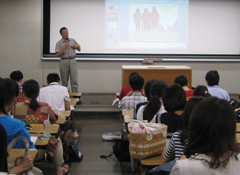Top>Hakumon CHUO [2011 Autumn Issue]>[Open Campus]Mock lesson for everyone Interested in Chuo University
 Index
Index
[Open Campus]Mock lesson for everyone Interested in Chuo University
Evolutionary biodiversity science-Exploring the history of biodiversity
Harufumi Nishida
Professor, Faculty of Science and Engineering, Chuo University
Thanks in part to the beautiful weather, a large number of high school students visited the Korakuen Campus on July 24th, the first day of open campus for the Faculty of Science and Engineering. Mock lectures which enable participants to directly experience university classes are a popular event among high school students. The classroom used for the mock lecture given by Professor Nishida (Department of Life Sciences) was filled to the point where only standing room was available 10 minutes prior to the start of the class. There were a particularly large number of female high school students in attendance.
Considering changes in the earth and life

Professor Harufumi Nishida
"Life changes as it passes through time and space," stated Professor Nishida to begin the lecture. Based on the theme of considering changes in the earth and life, he conducted the lecture while discussing his experience participating in an Antarctica research team from Chile. The professor participated in the research team this January for the purpose of researching plant fossils.
In order to consider changes in the earth and life, Professor Nishida raised the example of distribution for the Antarctic beech tree. The Antarctica beech is currently widely distributed throughout southern regions of South America, as well as Tasmania Island, New Zealand, New Caledonia and other regions of Oceania.
"The seeds of the Antarctica beech are not eaten by birds and have no resistance to sea water. Therefore, it is impossible for the seeds to cross the ocean," explained Professor Nishida. "Therefore, this distribution has been a mystery for a long time." This explanation captured the attention of the high school students.
The mystery was solved through research involving continental drift and fossils. A series of research revealed that Oceania regions such as Australia and New Caledonia were connected with South America in the past via Antarctica. Common species of life existed on this connected land mass. "Antarctica and South America were joined 90 million years ago," explained Professor Nishida. "However, they began to separate 70 million years ago. Afterwards, Antarctica became a frozen landmass and the Antarctica beech became extinct from the continent."
Extracting trash fossils from Antarctica
Professor Nishida joined the Antarctic research team from Chile in order to search for trash fossils in Antarctica. Trash fossil, a term coined by the professor, refers to fossils which contain numerous plant fragments. If such fossils can be found on Antarctica, then we can understand the rich biota which existed when Antarctica was a warm continent in the past. "By investigating trash fossils, it is possible to understand the details of Antarctica's ecosystem in the past," emphasized the professor.
The research mission experienced bad weather during their time in Antarctica. Even after moving to their destination by helicopter, they were forced to stay inside their tents all day for many days at a time. Through hard effort, Professor Nishida was able to find fossils of a tree trunk and leaves. These findings were reported by local media and were the subject of great attention.
Biodiversity guarantees a stable environment
In the second half of his lecture, Professor Nishida discussed how energy is necessary for organisms to live. "Organic matter is the basis of the metabolism which supports life. The production of such organic matter is guaranteed by a stable environment and ecosystem," he emphasized. However, he also pointed out how this stable environment has been placed in danger due to the greenhouse effect and destruction of nature in recent years. Life on earth is maintained by photosynthesis. Therefore, failure of the ecosystem would place mankind in immediate danger. "Biodiversity guarantees a stable environment," said the professor while emphasizing the importance of biodiversity.
Professor Nishida finished his lecture by making a subtle appeal for the Department of Life Science to the listening high school students: "The field of life science is full of unanswered questions. If you enter the Department of Life Science, I guarantee that you will have a fulfilling four years at university." It seems as though the students had felt the appeal of the Department of Life Science, because many of the female high school students asked questions directly to the professor after class. Professor Nishida answered everyone's question carefully.
(Student Reporter: Yuki Tanaka, 2nd year student, Faculty of Science and Engineering)
- Research Activities as a Member of Research Fellowship for Young Scientists (DC1), Japan Society for the Promotion of Science (JSPS) Shuma Tsurumi
- Important Factors for Innovation in Payment Services Nobuhiko Sugiura
- Beyond the Concepts of Fellow Citizens and Foreigners— To Achieve SDGs Goal 10 “Reduce Inequality Within and Among Countries” Rika Lee
- Diary of Struggles in Cambodia Fumie Fukuoka
- How Can We Measure Learning Ability?
—Analysis of a Competency Self-Assessment Questionnaire— Yu Saito / Yoko Neha - The Making of the Movie Kirakira Megane








